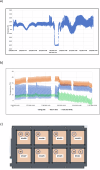Simulated deep space exposure on seeds utilizing the MISSE flight facility
- PMID: 39824863
- PMCID: PMC11742015
- DOI: 10.1038/s41526-024-00451-y
Simulated deep space exposure on seeds utilizing the MISSE flight facility
Abstract
The MISSE-Seed project was designed to investigate the effects of space exposure on seed quality and storage. The project tested the Multipurpose Materials International Space Station Experiment-Flight Facility (MISSE-FF) hardware as a platform for exposing biological samples to the space environment outside the International Space Station (ISS). Furthermore, it evaluated the capability of a newly designed passive sample containment canister as a suitable exposure unit for biological samples for preserving their vigor while exposing to the space environment to study multi-stressor effects. The experiment was launched to the ISS on Northrup Grumman (NG)-15. The exposure lasted eight months outside the ISS in the MISSE-FF at the Zenith position. The specimens consisted of eleven seed varieties. Temperature dataloggers and thermoluminescent dosimeters were included in each container to record environmental data. We presented here the hardware and experimental design, environmental profiles, and seed survival from post-flight germination tests.
© 2025. This is a U.S. Government work and not under copyright protection in the US; foreign copyright protection may apply.
Conflict of interest statement
Competing interests: J.T.R., J.L.G., and J.A.F. were employed by the company AETOS Systems Inc. under the NASA LASSO II contract. T.E.M. was employed by the company Bionetics Corp. under the NASA LASSO contract. C.J.S., L.E.S., and C.L.K. were employed by Noetic Strategies, Inc., under the NASA LASSO II contract. J.G.B. was employed by Aegis Aerospace Inc. under a NASA REMIS contract. The remaining authors declare that the research was conducted in the absence of any commercial or financial relationships that could be construed as a potential conflict of interest. The funders had no role in the design of the study, in the collection, analysis, or interpretation of data, in the writing of the paper, or in the decision to publish the results.
Figures







References
-
- Dachev, T. P. et al. Overview of the ISS radiation environment observed during the ESA EXPOSE-R2 mission in 2014–2016. Space Weather15, 1475–1489 (2017).
-
- Rabbow, E. et al. The astrobiological mission EXPOSE-R on board of the International Space Station. Int. J. Astrobiol.14, 3–16 (2015).
LinkOut - more resources
Full Text Sources

